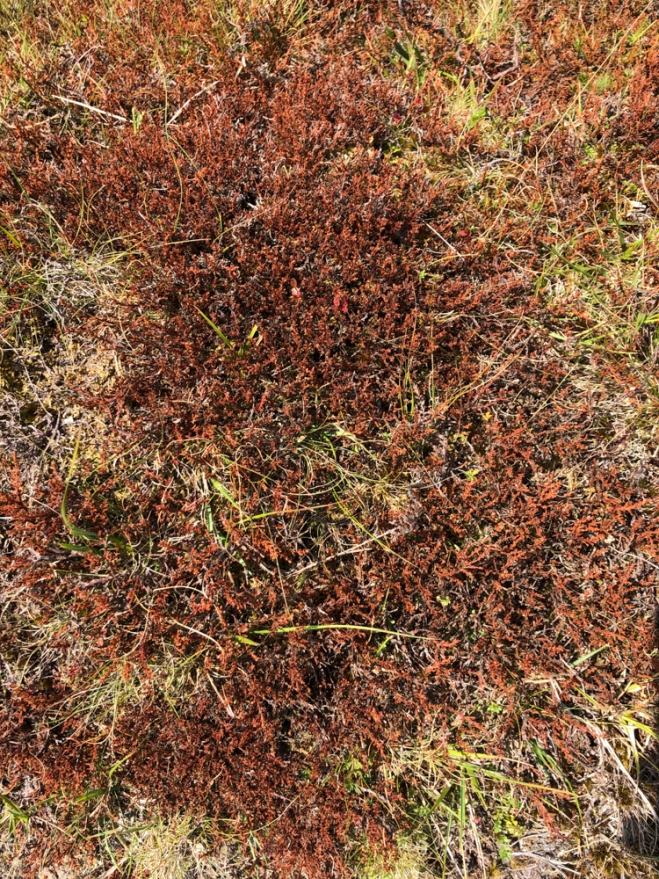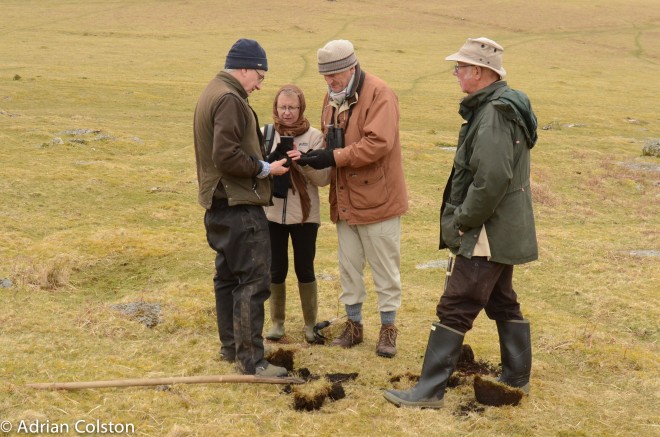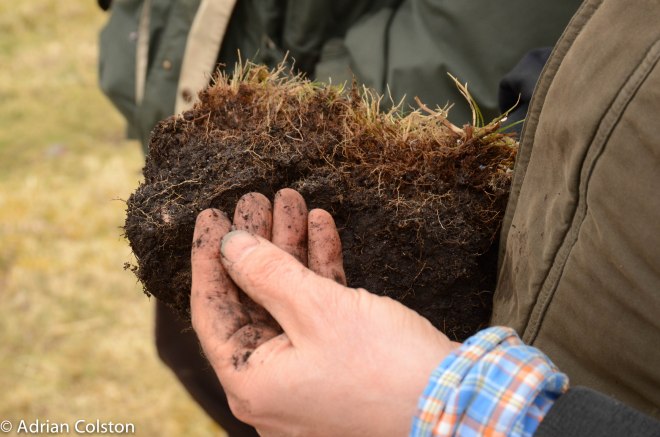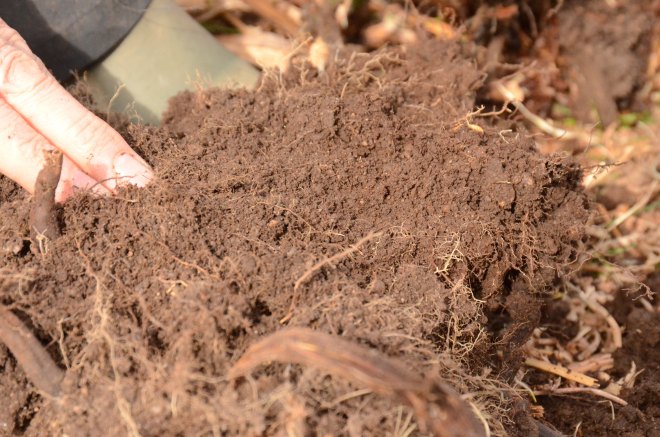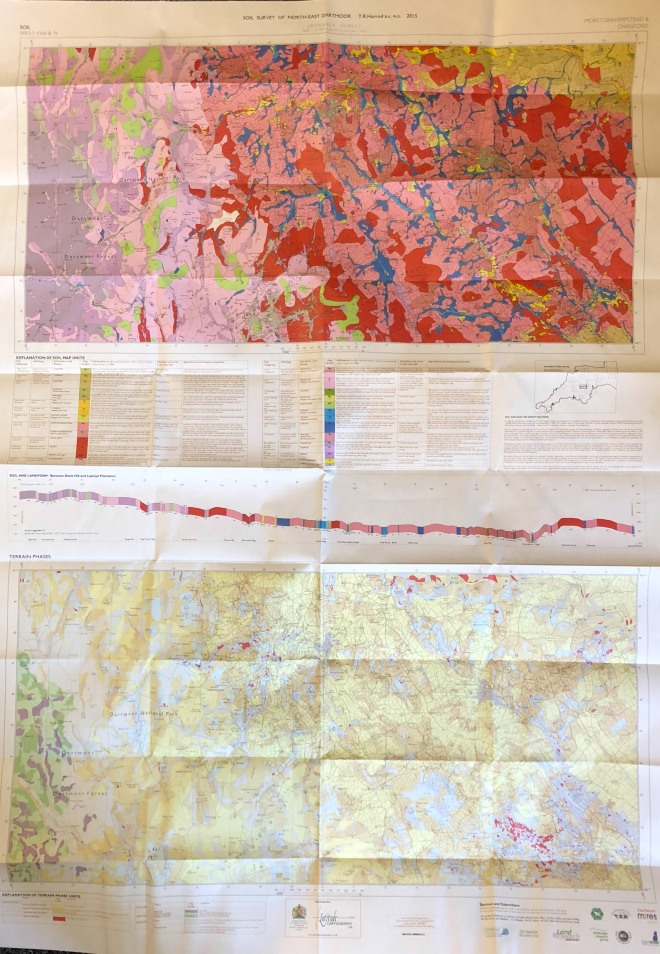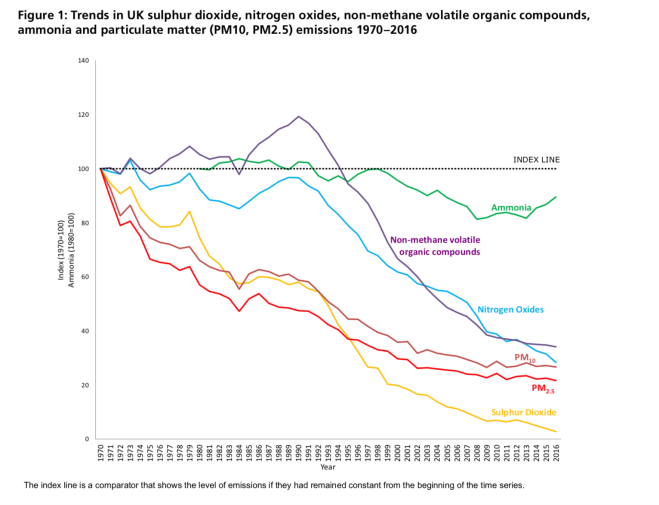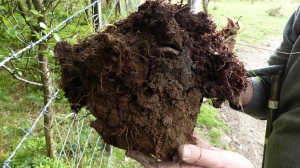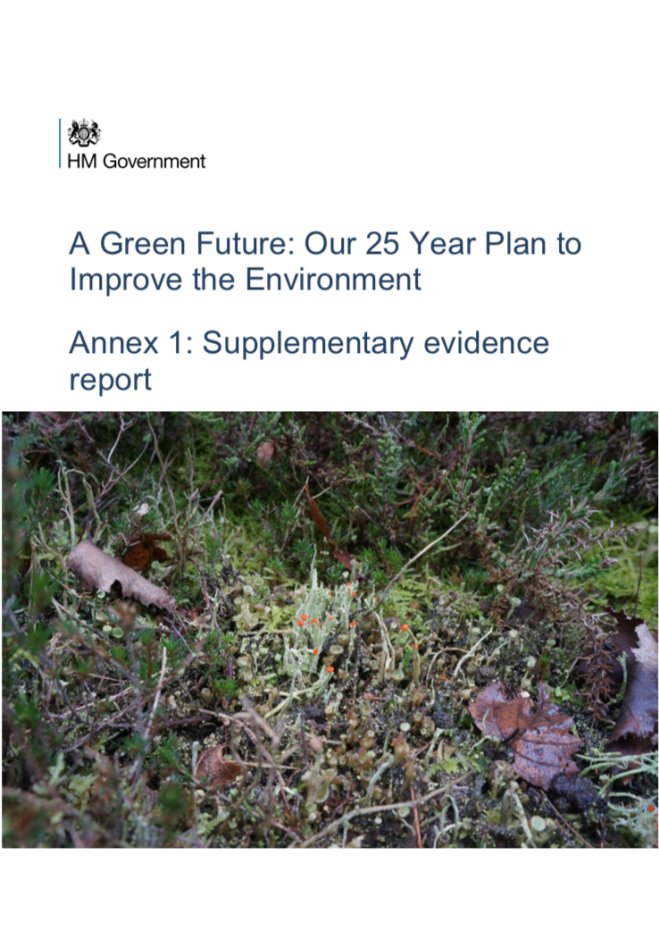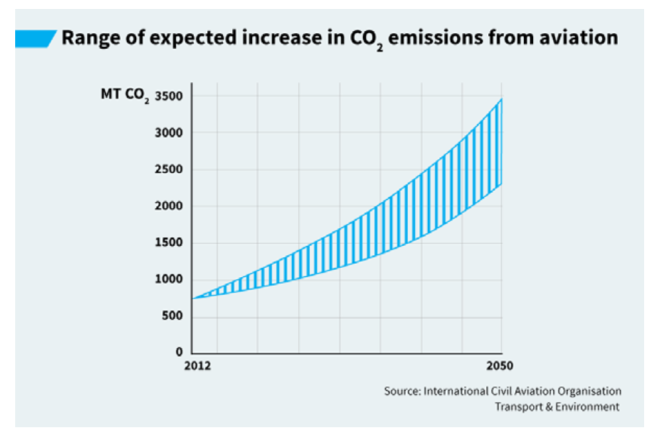Since the Industrial Revolution humans have altered the natural biogeochemical cycles by increasing the availability of biologically reactive forms of natural elements such as nitrogen (Caporn & Emmett 2009).
In the UK, there are two distinct forms of nitrogen pollution – nitrogen oxides (NOx) and ammonia (NH3). Emissions from vehicles, power stations and factories are largely responsible for NOx, whilst emissions from agriculture (livestock manures and fertilisers) account for the majority of NH3.
NOx compounds (known as oxidised nitrogen) can be deposited ‘wet’ i.e. in rain as nitrate (NO3) or ‘dry’ i.e. as a gas as nitrogen oxide (NO2). NH3 compounds (known as reduced nitrogen) can be deposited wet as ammonium (NH4) or dry as ammonia gas (NH3). NOx and NH3 compounds cause acidification (lowering the pH) and eutrophication (increasing nutrient levels).
NOx emissions peaked around 1990 and by 2015 had fallen 69% compared to the 1970 level. Ammonia levels have by comparison fallen just 9.9% between 1980 and 2015 (Defra 2015).
However, despite the large falls in nitrogen emissions, the deposition of all nitrogen compounds has hardly fallen at all. This unexpected situation has arisen as the atmospheric chemistry over Britain has been altered leading to more rapid oxidisation of nitrogen. This rapidly oxidised nitrogen is deposited in the UK when previously it would have been exported to Continental Europe (RoTAP 2012).
As a result, many parts of the UK have been receiving high levels of nitrogen deposition for decades.

This map shows nitrogen deposition between 2011-2013
 This map shows ammonia concentrations
This map shows ammonia concentrations
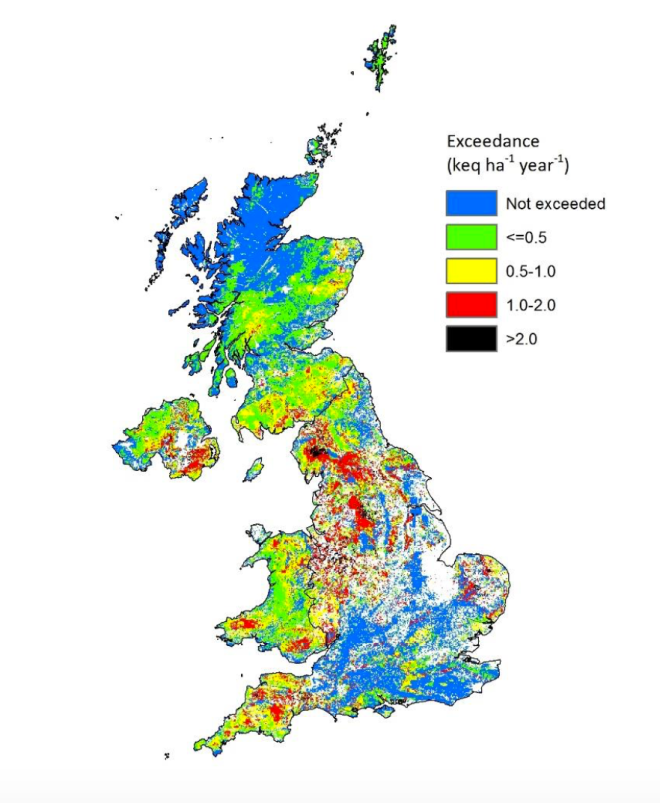
This map shows acidity
(Source: Centre for Ecology and Hydrology).
Brown & Farmer (1996) showed that between 1989-92 total (oxidised and reduced) nitrogen deposition exceeded critical loads on Dartmoor in 841km2 out of a total of 901.77 km2 i.e. 93.3% of the total – making it the second most affected Natural Area in England.
Critical load is defined as the amount of acid or nitrogen deposition below which significant harmful effects do not occur to sensitive habitats. ‘Exceedance’ is the amount of excess acid or nitrogen deposition above this critical load (Hall & Smith 2015).
| Table showing the actual atmospheric pollution levels or the Blanket Bogs, Atlantic Wet Heaths with Erica tetralix and European Dry Heaths along with the exceedance loadings |
| Nitrogen Deposition
kg N/ha/yr |
Acid Deposition
Nitrogen | Sulphur keq/ha/yr |
Ammonia Concentration
µg/m3 |
NOx Concentration
µg/m3 |
SO2 Concentration
µg/m3 |
| Maximum: 30.38
Minimum: 14.28
Average: 21.65 |
Maximum: 2.17 | 0.5
Minimum: 1.02 | 0.21
Average: 1.55 | 0.35 |
Maximum: 1.63
Minimum: 0.51
Average: 0.75 |
Maximum: 8.09
Minimum: 4.05
Average: 4.9 |
Maximum: 0.75
Minimum: 0.43
Average: 0.5 |
| Empirical Critical Load kg N/ha/yr |
Acidity Critical Loads (keq) |
Critical Level
(µg NH3/m3 annual mean) |
Critical Level
(µg NOx/m3 annual mean) |
Critical Level
(µg SO2/m3 annual mean) |
| Blanket bog 5-10
|
Wet heath 10-20
Dry heath 10-20
|
MinCLMaxN: 0.830 MaxCLMaxN: 1.363 |
1 |
30 |
75 |
| Habitats with Critical Load Exceedances on Dartmoor |
| Blanket bog
|
Atlantic Wet heath
European Dry Heath
|
Blanket bog |
Blanket bog
|
Atlantic Wet heath
European Dry Heath
(maximums but not averages)
|
No exceedance |
No exceedance |
Source: Air Pollution Information Service http://www.apis.ac.uk/ (accessed 24/3/17)
There is an extensive academic literature on the implications of atmospheric nitrogen pollution for semi-natural habitats. Bobbink et al (1998) in an Essay Review highlight the three main impacts:
- Accumulation of nitrogenous compounds resulting in enhanced availability of nitrate and ammonium
- Soil mediated effects of acidification
- Increased susceptibility to secondary stress factors
Stevens et al (2004) reported that long-term chronic nitrogen deposition had significantly reduced plant species richness. Their study (which included a Dartmoor site) found that for every 2.5kg N ha-1 of nitrogen deposition one species per 4m2 quadrat was lost. At the time of their study they suggested that with an average nitrogen deposition rate of 17 kg N ha-1 yr -1 there was a 23% reduction in species richness compared to sites receiving the lowest levels of atmospheric nitrogen.
Similar results were found in additional surveys on this topic (Stevens et al 2010 and Stevens et al 2011). van den Berg et al (2016) analysed the British Countryside Survey data and also found clear evidence for nitrogen deposition effects on plant species richness. Their research also suggested that mires and heaths were more sensitive to ammonia deposition than nitrate deposition.
Field et al (2014) found that whilst the diversity of mosses, lichens, forbs and graminoids decline, the cover of graminoids increases.
Kirkham (2001) conducted a study on 8 eight moorland sites including one on Dartmoor and found that the accumulation of nitrogen had changed a substantial proportion of the Heather (Calluna vulgaris) dominated uplands from nitrogen limited ecosystems into phosphorus limited ones. He suggested that this favoured Purple Moor Grass (Molinia caerulea) as it was a species that was better adapted to phosphorus limitation.
However, Bobbink et al (2010) describes a more complex relationship between nitrogen, Molinia and Calluna. They suggest from studies in the Netherlands that nitrogen deposition increases the productivity of the dwarf shrubs such as Calluna and that if the dwarf shrub canopy remains closed then the dwarf shrubs remain the stronger competitor against grasses such as Molinia and Tufted Hair Grass (Deschampsia flexuosa). However if the dwarf shrubs canopy is opened up by disturbance then the grasses can become dominant.
Bobbink et al (2010) also state that disturbance to the dwarf shrub canopy by either Heather Beetle (Lochmaea suturalis) attack, winter frost injury or drought are increased in likelihood by enhanced nitrogen deposition. Kirkham (2001) also found that nitrogen deposition led to increased concentrations of nitrogen in the growing shoots of Calluna and he cites an unpublished report by S.E Hartley which suggested that this made the Calluna plants more susceptible to increased grazing pressure by sheep. He then concluded that increased nitrogen content in the shoots of Calluna resulting from atmospheric pollution may therefore be playing a part in the deterioration of Calluna moorland caused by overgrazing.
Payne et al (2013) found that approximately 60% of all plant species studied react adversely to nitrogen deposition at levels below the published critical load exceedances.
The effects of nitrogen deposition are not related only to plant communities. Fox et al (2014) in a study of the long-term changes in British moth communities found that moth species associated with low nitrogen, based on their larval host plant characteristics, declined most strongly. In a study from Sweden Ockinger et al (2006) reported that butterfly species which relied on nutrient poor conditions tended to decrease whilst those reliant on nutrient rich conditions tended to increase. They suggested that this indicated a negative effect of increased nitrogen in the soil resulting from the active fertilizing of pastures and / or atmospheric nitrogen deposition.
Payne (2014) writing about the exposure of British peatlands to nitrogen deposition concluded that ‘nitrogen deposition is a serious threat to British peatlands and is likely to remain so for some time to come’.
In a study looking at the likely impacts of nitrogen deposition up to 2030 Stevens et al (2016) state that for heaths and bogs ‘we project overall reductions in species richness with decreased occurrence of tricolours lichens and some bryophytes, reduced cover of dwarf shrubs and a small increase in grasses’.
Addressing the question of how long do ecosystems take to recover from atmospheric nitrogen deposition Stevens (2016) concluded ‘There are a number of barriers to recovery such as continued critical load exceedance and lack of seed bank or local seed source, and there is potential for vegetation communities to reach an alternative stable state where species lost as a consequence of changes due to nitrogen deposition may not be able to recolonise.’
Whilst the conservation agencies and N.G.O.s were quick to respond to the threat posed by sulphur dioxide pollution and ‘acid rain’ in the 1970s and 1980s they have been much slower to respond to the threat posed by nitrogen pollution. English Nature published a report in 2004 (Bignall et al 2004) on the ecological effects of diffuse pollution from road traffic but that was as much a response to the requirement to provide planning authorities advise on new roads schemes – the report looked at localised impacts rather than diffuse ones.
In 2011, the Joint Nature Conservation Committee published a series of reports it had commissioned on the evidence of nitrogen deposition impacts on vegetation (Stevens et al 2011, Emmett et al 2011 and JNCC 2011). This work provided a new analysis of eight national scale datasets which showed significant responses in cover and presence of 91 plant and lichen species in relation to nitrogen deposition. The summary report concluded that ‘nitrogen deposition is compromising our ability to deliver current conservation commitments such as the objective to achieve Favourable Condition Status under the Habitats Directive.’ This report also contained various recommendations for the country agencies.
Natural England (2015) published a document entitled ‘Atmospheric nitrogen theme plan – developing a strategic approach for England’s Natura 2000 sites. The plan reported that in England 80% of sensitive Special Areas of Conservation (SAC) and 70% of sensitive Special Protection Areas (SPA) are estimated to exceed the critical load for one or more of their protected features.
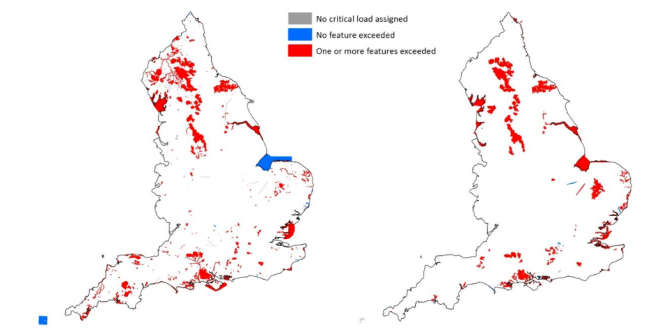
Exceedance of nitrogen site relevant critical loads for SACs (left) and SPAs (right)
As can be seen from the left hand map both of Dartmoor’s moorland SACs exceed the critical load levels.
The document also contains a table setting out the threats from nitrogen for each of England’s SACs. The Dartmoor relevant section is set out in the following table.
| SAC Name |
Sensitivity code |
Level of CL exceedance |
Likelihood of N impact |
Relevance of local agricultural NH3 sources |
Potential significance of local NH3 measures |
| Dartmoor |
Very sensitive
|
CL 5-10 kg N/ha/yr
|
Very high
|
CL exceedance > 28kg N/ha/yr
|
Very likely
|
Sensitive and high level of CL exceedance
|
Medium
|
Agricultural deposition 20-40%, NH3 dry deposition > 10-20 kg N /ha/yr
NH3 emissions within 2-3km of site 6-10 kg N /ha/yr
|
Medium |
The theme plan then proposes a trial of ‘Site Nitrogen Action Plans’ (SNAP) which would document:
- The current status of the site in terms of nitrogen deposition and attribution of this nitrogen to identify the most significant sources,
- The expected future decline in background deposition at the site as a result of existing national and international measures,
- Coordinated locally targeted measures to reduce the contribution of local sources where feasible and appropriate,
- Habitat restoration and management measures that mitigate the impact of atmospheric nitrogen.
- Five trial sites have been selected in England, the nearest one to Dartmoor is the Culm Grasslands SAC and the most similar one to Dartmoor in habitat type and size is the South Pennines SAC.
At this point it is not clear what progress has been made on the trial SNAPs. However Natural England’s published Site Improvement Plan (SIP) for Dartmoor [1] has listed ‘Air pollution: impact of nitrogen deposition’ as its third priority area (behind ‘Hydrological Changes’ and ‘Wildfire / Arson’) although at this point no budget has been allocated and no ‘delivery partners’ have been identified.
The impact of atmospheric nitrogen pollution has recently received more profile and publicity with the publication of a report by Plantlife (2017) ‘We need to talk about nitrogen – the impact of atmospheric nitrogen deposition on the UK’s wild flora and fungi’. It would appear that the problems of atmospheric nitrogen pollution are becoming more widely known but there are still many conservation managers who are still unaware of the issue.
Unfortunately raising the profile of the issue is likely to prove easier than solving the problem – the measure suggested in the Dartmoor SIP is ‘control, reduce and ameliorate atmospheric nitrogen impacts’, which as this review shows will be easier said than done.
References
Aerts R., Berendse F., de Caluwe H. & Schmitz M. (1990) Competition in Heathland along an Experimental Gradient of Nutrient Availability. Oikos 57: 310-318.
Averis A., Averis B., Birks J., Horsefield D., Thompson D. & Yeo M. (2004) An Illustrated Guide to British Upland Vegetation. Joint Nature Conservation Committee. Peterborough.
Bonn A., Allott T., Hubacek K. & Stewart J. (2009) Drivers of Environmental Change in Uplands. Routledge. London.
Bignal K., Ashmore M. & Power S. (2004) The ecological effects of diffuse air pollution from road transport. English Nature Research Reports Number 580
Bobbink R., Hicks K., Galloway J., Spranger T., Alkemade R., Ashmore M., Bustmante M., Cinderby S., Davidson E., Dentener F., Emmett B., Erisman J.-W., Fenn M., Gilliam F., Nordin A., Pardo L. & De Vries W. (2010) Global assessment of nitrogen deposition effects on terrestrial plant diversity: a synthesis. Ecological Applications 20 (1): 30-59.
Bobbink R., Hornung M. & Roelofs J.G.M. (1998) The effects of air-bourne pollutants on species diversity in natural and semi-natural European vegetation. Journal of Ecology 86: 717-738.
Brown M. & Farmer A. (1996) Excess sulphur and nitrogen deposition in England’s Natural Areas. English Nature Research Reports No. 201.
Burt T.P., Thompson D.B.A. & Warburton J. (2002) The British Uplands: Dynamics of Change. Joint Nature Conservation Committee Report No. 319.
Caporn S. J. M., Rosenburg A. E. & Field C.D. (2015) The importance of atmospheric quality in determining upland vegetation. In Meade R. (ed) (2015)
Caporn S.J.M. & Emmett B.A. (2009) Threats from air pollution and climate change to upland systems. In Bonn et al (2009) pp34-58
Caporn S.J.M., Carroll J.A., Dise N.B. & Payne R.J. (2014) Impacts and indicators of nitrogen deposition in moorlands: results from a national pollution gradient study. Ecological Indicators 45: 227-234.
Chambers F.M. Mauquoy D. & Todd P. (1999) Recent rise to dominance of Molinia caerulea in environmentally sensitive areas: new perspectives from paleo ecological data. Journal of Applied Ecology 36: 719-733.
Defra (2015) Emissions of air pollutants in the
UK, 1970-2014, Statistical Release: 17 December 2015, Defra National Statistics https://www.gov.uk/government/ uploads/system/uploads/attachment_data/ le/486085/Emissions_of_air_pollutants_statistical_ release_2015_-_Final__2_.pdf
Emmett, B.A., Rowe, E.C., Stevens, C.J., Gowing, D.J., Henrys, P.A., Maskell, L.C. & Smart, S.M. 2011. Interpretation of evidence of nitrogen impacts on vegetation in relation to UK biodiversity objectives. JNCC Report 449. http://jncc.defra.gov.uk/page-5895
Field C., Dise N., Payne R., Britton A., Emmett B., Hallowell R., Hughes S., Jones L., Lees S., Leake,J., Leith I., Phoenix G., Power S., Sheppard L., Southon G., Stevens C. and Caporn S. M. (2014). The Role of Nitrogen Deposition in Widespread Plant Community Change Across Semi-natural Habitats. Ecosystems 17(5): 864-877
Fox R., Oliver T. H., Harrower C., Parsons M. S., Thomas C. D & Roy, D. B. (2014), Long-term changes to the frequency of occurrence of British moths are consistent with opposing and synergistic effects of climate and land-use changes. Journal of Applied Ecology, 51: 949–957.
Hall J. & Smith R. (2015) Trends in critical load exceedances in the UK. CEH. http://www.cldm.ceh.ac.uk/sites/cldm.ceh.ac.uk/files/TrendsReport_June2015_WEB.pdf
Hall J., Dore T., Smith R., Evans C., Rowe E., Bealey B., Roberts E., Curtis C., Jarvis S., Henrys P., Smart S., Barrett G., Carter H., Collier R. & Hughes P. (2016). Defra Contract AQ0826: Modelling and mapping of exceedance of critical loads and critical levels for acidification and eutrophication in the UK 2013-2016 Final Report: 25 July 2016, accessed on 16 December 2016 at: https://uk-air.defra.gov.uk/ assets/documents/reports/cat13/1611011543_ AQ0826_FinalReport_25July2016.pdf
JNCC (2011) Evidence of nitrogen deposition impacts on vegetation: implications for country strategies and UK biodiversity commitments. This is a summary of JNCC reports 447 & 449. http://jncc.defra.gov.uk/pdf/Project%20summary%20v4_final.pdf
Kirkham F.W. (2001) Nitrogen uptake and nutrient limitation in six hill moorland species in relation to atmospheric nitrogen deposition in England and Wales. Journal of Ecology 89: 1041-1053.
Marrs R.H., Phillips J.D.P., Todd P.A., Ghorbani J. & Le Duc M.G. (2004) Control of Molinia caerulea on upland moors. Journal of Applied Ecology 41:398-411.
Meade R. (ed) (2015) Managing Molinia. Proceedings of a 3-day conference 14-16 September 2015, Huddersfield, West Yorkshire, UK. National Trust.
Natural England (2015) Atmospheric Nitrogen Theme Plan. Developing a strategic approach for England’s Natura 2000 sites. Improvement Programme for England’s Natura 200 Sites – Planning for the future. http://publications.naturalengland.org.uk/ publication/6140185886588928
Payne R. J. (2014) The exposure of British Peatlands to nitrogen deposition 1900-2030. Mires and Peat volume 14, Article 04 pp1-9.
Payne R. J., Dise N.B., Stevens C. J. Gowing D. J. & BEGIN partners (2013) Impact of nitrogen deposition at the species level. PNAS 110: 984-987.
Plantlife (2017) We need to talk about nitrogen. The impact of atmospheric nitrogen deposition on the UK’s wild flora and fungi. http://www.plantlife.org.uk/application/files/3514/8935/6858/We_need_to_talk_about_Nitrogen_FINAL_webpdf.pdf
Rodwell J. S. (ed) (1991) British Plant Communities. Volume 2. Mires and heaths. Cambridge University Press. Cambridge.
RoTAP (2012). Review of Transboundary Air Pollution: Acidification, eutrophication, ground level ozone
and heavy metals in the UK. Centre for Ecology and Hydrology, Edinburgh. Available from: http://www. rotap.ceh.ac.uk/
Stevens C., Jones, L., Rowe E., Dale S., Hall J., Payne R., Evans C., Caporn S., Sheppard L., Menichino N. & Emmett B. (2013) Review of the effectiveness of on-site habitat management to reduce atmospheric nitrogen deposition impacts on terrestrial habitats. Countryside Council for Wales. (CCW Science Report no: 1037 (A), CEH Project no. C04949)
Stevens C.J., (2016). How long do ecosystems take to recover from atmospheric nitrogen deposition? Biological Conservation, Vol. 200: 160-167
Stevens C.J., Dise N.B., Mountford J.O. & Gowing D.J. (2004) Impact of nitrogen deposition on the species richness of grasslands. Science 303: 1876-1879.
Stevens C.J., Dupre C., Dorland E., Gaudnik C., Gowing D.J.G., Bleeker A., Diekmann M., Alard D. Bobbink R., Fowler D., Corcket E., Mountford J.O., Vandvik V., Aarrestad P.A., Muller S. & Dise N.B. (2010) Nitrogen deposition threatens species richness of grasslands across Europe. Environmental Pollution 158: 2940-2945.
Ockinger E., Hammarstedt O., Nilsson S.G. & Smith H.G. (2006) The relationship between local extinctions of grassland butterflies and increased soil nitrogen levels. Biological Conservation 128: 564-573.
Stevens C.J., Dupre C., Dorland E., Gaudnik C., Gowing D.J.G., Bleeker A., Diekmann M., Alard D. Bobbink R., Fowler D., Corcket E., Mountford J.O., Vandvik V., Aarrestad P.A., Muller S. & Dise N.B. (2011) The impact of nitrogen deposition on acid grasslands in the Atlantic region of Europe. Environmental Pollution 159: 2243-2250.
Stevens C.J., Payne R.J., Kimberley A. & Smart S.M. (2016) How will the semi-natural vegetation of the UK have changed by 2030 given the likely changes in nitrogen deposition? Environmental Pollution 208: 879-889.
Stevens, C.J., Smart, S.M., Henrys, P.A., Maskell, L.C., Walker, K.J., Preston, C.D., Crowe, A., Rowe, E.C., Gowing, D.J. & Emmett, B.A. 2011. Collation of evidence of nitrogen impacts on vegetation in relation to UK biodiversity objectives. JNCC Report 447. http://jncc.defra.gov.uk/page-5894
Terry A.C., Ashmore M.R., Power S.A., Allchin E.A. & Heil G.W. (2004) Modelling the impacts of atmospheric deposition on Calluna-dominated ecosystems in the UK. Journal of Applied Ecology 41: 897-909.
Thompson D.B.A. (2002) The importance of nature conservation in the British uplands: nature conservation and land-use changes. In Burt et al (2002) p37.
van den Berg L.J.L., Jones L., Sheppard L.J., Smart S.M., Bobbink R., Dise N.B. & Ashmore M.R. (2016) Evidence of the differential effects of reduced and oxidised nitrogen deposition on vegetation independent of nitrogen load. Environmental Pollution 208:890-897.
Wedlich K.V., Rintoul N., Peacock S. Cape J.N., Coyle M. Toet S, Barnes J. & Ashmore M.(2012) Effects of ozone on species composition in an upland grassland. Oecologia 168: 1137-1146
Wolton R.J., Edge S., Keddle R.M., Kendall S. & Archer R. (1994) Vegetation and Heather Condition Maps for the Commons of Dartmoor. A practical aid to their sensitive management. English Nature Report (unpublished).
[1] http://publications.naturalengland.org.uk/publication/4508672642252800










